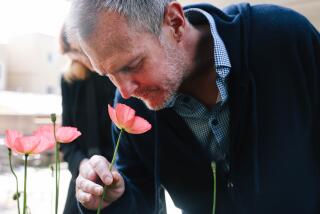‘Rehab Radio’ Is Social Therapy
- Share via
When you’re in the hospital, the outside world can sometimes seem a thousand miles away.
That’s especially true for long-term rehabilitation patients, who often spend weeks or even months as inpatients undergoing therapy for strokes, brain injuries or other major problems. For patients who have trouble moving or communicating, the isolation is compounded.
But at St. Jude Hospital and Rehabilitation Center in Fullerton, rehab patients have a way to reach beyond the walls and make new friends without interrupting therapy. It’s called Rehab Radio.
“CQ, CQ, CQ, 10 meters, Whiskey Delta Six Bravo Poppa Tango,” says volunteer April Moell, enunciating clearly into the microphone she’s holding. Behind her is an amateur radio transceiver; in front of her is a roomful of patients in wheelchairs.
“CQ is like, ‘I’m seeking you,’ ” Moell explains. “It’s kind of like fishing.”
Then, before anyone has a chance to shy away, she moves around the room with the microphone like an amateur radio Oprah Winfrey, making sure everyone has a chance to try. By the time all the CQs have been spoken, responses are coming in so fast they’re overlapping, and Moell hurries to write down all the call letters she can.
“We’ve attracted a crowd,” she says.
It’s a bright sunny afternoon in Fullerton, and apparently other atmospheric conditions are favorable as well. “Yesterday we couldn’t even talk next door, let alone to California,” says the voice that comes through the radio. Her name is Pat, and she’s in Virginia. “It looks like we’re finally going to get some sunshine here today,” she says.
Moell gives the rehab patients a chance to introduce themselves. For some, like Viola Grace, it isn’t easy. She suffered a stroke a few weeks earlier, and although she has improved since she arrived at the hospital, she still has trouble speaking her name.
“Vi . . . la,” she says.
“Vi-O-la,” Moell tells her.
“Vi-O-la,” she repeats into the microphone, much clearer this time.
A longtime amateur radio enthusiast, Moell founded the St. Jude radio program 11 years ago when a local widow donated her late husband’s ham equipment to the hospital. A therapist herself--until last month, she was director of occupational therapy at St. Jude--Moell finds ways to individualize the radio sessions to complement each patient’s therapy.
In addition to helping Grace with her speech, for example, Moell works with another stroke patient who needs to relearn the left-to-right visual pattern necessary for reading. For that, she gives him a turn at reading the weather report on the air.
Even if all they can manage is a barely audible “Hi,” in the case of one brain-injury patient, Moell tries to include everyone. And the folks out there in radio land try to do the same.
“I would definitely like to put all your names in my log,” Pat says.
Most of the program’s radio contacts send in QSL cards--post cards used in ham radio to acknowledge a contact--and some go so far as to send individual cards for everyone who was at the session, Moell says. “That really means a lot to them.” And the rehab patients reciprocate as they can. “If they can’t write, then we let them stamp the cards,” Moell says. One radio contact who lived nearby dropped by to deliver QSL cards in person, she says.
“Most hams have been really wonderful. They seem to sense what’s going on,” she says. She also explains the situation over the radio, answering questions about the program from curious radio operators.
During this session, hams across the nation and in Canada acknowledged the group’s “CQs” and waited patiently for a turn.
“This is my first experience talking to people in therapy,” says Pat, who listened as the patients talked, at Moell’s prompting, about what they like to do when they’re not in the hospital, and what kind of therapy they’re working on.
“Walking and my leg,” Grace says. Her husband, John, sits next to her and offered encouragement.
After everyone has had a chance to talk to Pat, she signs off and gives others a chance to talk to the Fullerton group. They meet Harry, a retired optometrist in Mississippi, and Randy, a minister in Indiana, as well as two men on opposite sides of the U.S.-Canadian border in New York and Ontario.
“That’s what we call good wheelchair copy,” Moell says to one contact whose transmission is coming in strong. “We can hear you clearly all over the room.”
Hams use phonetics to make their call letters understandable, and Moell often deviates from the preferred words to make a humorous point. “This is Whiskey Delta Six Bed Pan Trainer,” she says, reminding her audience that the transmission is coming from inside a hospital. “They always get that right away,” she says.
“It’s really important for them to maintain contact with the outside world,” says Richard Boyle, a recreational therapist who works with Moell on the program. “We’ve even had patients who’ve gone on and gotten their ham radio licenses after trying it here.”
The feeling of isolation isn’t so bad for those who have frequent visitors, says Bob Grigsby, a spinal cord injury patient who enjoys participating in the radio sessions. “My family has been very supportive, but everybody doesn’t have that,” he says.
“We’ve had people who’ve gotten kind of teary-eyed,” Moell says. “A lot of times the people out there will say, ‘We’ll say prayers for you at dinner tonight.’ It means a lot to think that there’s somebody they just met who cares about them who doesn’t have to. The staff here cares, too, but it’s their job. For the hams, it isn’t. But in a way, they’re therapists, too.”


